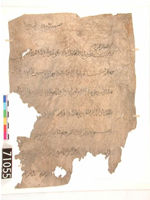| Homepage | Timeline | Maps | A-Z index | Learning |
Paper
The material of the paper used in Islamic Egypt was substantially linen. Paper in the middle ages made in the Near East was usually distinguished by its stout substance and glossy surface. It was devoid of watermarks. Paper was at this time very expensive.
In China paper was introduced according to the Hou han shu (the annals of the late Han dynasty - 25 - 220 AD) in 105 AD by Ts'ai Lun. In the the seventh century AD it was introduced in to Korea and Japan. In 751 AD Chinese and Arab armies clashed in Samarkand. The Chinese were defeated and many were taken prisoner. Among them were paper makers who bargained for their freedom by teaching the Arabs the secrets of paper making. Paper mills were subsequently set up in Baghdad, Damascus, Fustat and later in Morocco. Papermaking appears only in the twelfth century in Europe (Spain, Italy).
Medieval papermaking required vast quantities of linen for processing: one source, according to medieval historians such as Abd al-Latif of Baghdad, was found in the ancient Egyptian mummies - most cemeteries within reach of Cairo may have been emptied for the paper-trade, and the use of powdered resinous or bituminous mummy parts as medicine may be no more than a by-product of the paper trade. Until the fourteenth century AD, Egypt exported paper to Europe on a large scale; by the sixteenth century, this trade had been reversed, with imports of European wood-pulp paper. The paper-trading sector of the Cairo market was one of the most vibrant in the earlier centuries of Islam.
Paper page, bearing Arabic writing on both sides; maybe from Bahnasa/Oxyrhynchus
(click on the image for a larger picture)
